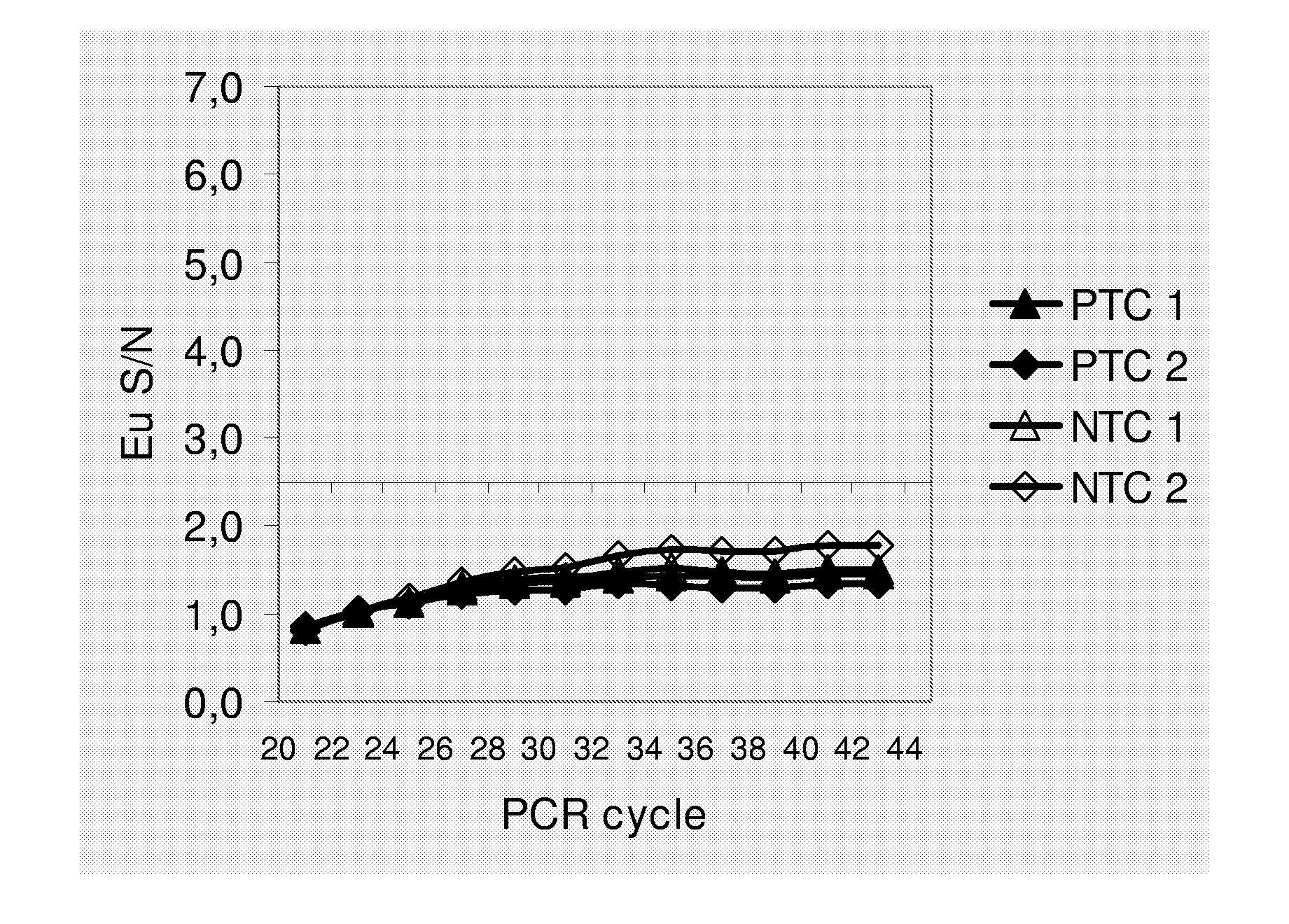Method for Stabilizing Assay Reagents, Reagent Container with Stabilized Assay Reagents and Use Thereof
a technology of assay reagents and liquid stabilizers, which is applied in the field of method for stabilizing assay reagents and reagent containers with stabilized assay reagents, can solve the problems of large amount of manual work, large amount of liquid handling equipment, and large amount of hands-on tim
- Summary
- Abstract
- Description
- Claims
- Application Information
AI Technical Summary
Benefits of technology
Problems solved by technology
Method used
Image
Examples
example 1
Stabilization of Dried Real-Time PCR Reagents
Materials and Methods
[0054] A closed-tube PCR assay was set up for Bacillus subtilis. Table 1 shows the sequences and modifications of all primer (SEQ ID NO: 1 ja 2) and probe (SEQ ID NO: 3 ja 4) oligonucleotides. The PCR assay chemistry, which is based on the use of lanthanide labelled probes, has been described by Nurmi et al. (2002). All PCR amplifications were performed in a volume of 30 μl containing 1× HotMaster Taq Buffer (Eppendorf, Germany); 2.5 mM MgCI2; 0.2 mM dNTPs; 0.3 μM forward and reverse primers; 28 nM lanthanide labelled probe; 280 nM quencher probe and 1.25 units of HotMaster Taq polymerase (Eppendorf, Germany).
TABLE 1OligonucleotidesLabel / OligonucleotideSequence from 5′ to 3′ endpositionB. subtilis 5′GCGGAGCAAGCTTCGTACCTTCTNoneprimerB. subtilis 3′CTAACGCCCAGAACACCGATTGAGTNoneprimerB. subtilisCCATACCAGGACGGCAGTTCTCAGCEu / 5′probeB. subtilisCTGCCGTCCTGGTATGGQSY-7 / 3′quenchermmPSA 5′ primerTGAACCAGAGGAGTTCTTGCANonemmPS...
example 2
Stabilization of Dried cDNA Synthesis Reagents
Materials and Methods
[0060] Reverse transcription reactions were performed using the High-Capacity cDNA Archive Kit (Applied Biosystems, USA) to reverse transcribe a constant amount (à 10 000 molecules) of mmPSA, which is an in vitro synthesized RNA species (Nurmi et al., 2002). As negative controls, reactions were also performed that contained water instead of template RNA. Three types of reactions (a-c) were prepared and compared: [0061] a. Normal cDNA synthesis reactions (10 μl volume) that were prepared and performed according to the instructions provided by the manufacturer. [0062] b. Dry chemistry reactions, where all reaction components except for the template RNA (buffer, dNTPs, random sequence oligonucleotides primers and reverse transcriptase) were pre-dispensed to the bottom of a reaction vessel and excess water was removed by air-drying. Sample RNA was added in a volume of 10 μl of water. [0063] c. Dry chemistry reactions...
PUM
| Property | Measurement | Unit |
|---|---|---|
| Diameter | aaaaa | aaaaa |
| Diameter | aaaaa | aaaaa |
| Diameter | aaaaa | aaaaa |
Abstract
Description
Claims
Application Information
 Login to View More
Login to View More - R&D
- Intellectual Property
- Life Sciences
- Materials
- Tech Scout
- Unparalleled Data Quality
- Higher Quality Content
- 60% Fewer Hallucinations
Browse by: Latest US Patents, China's latest patents, Technical Efficacy Thesaurus, Application Domain, Technology Topic, Popular Technical Reports.
© 2025 PatSnap. All rights reserved.Legal|Privacy policy|Modern Slavery Act Transparency Statement|Sitemap|About US| Contact US: help@patsnap.com



